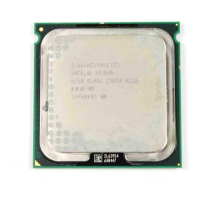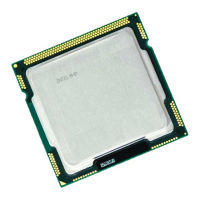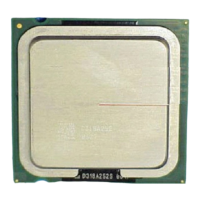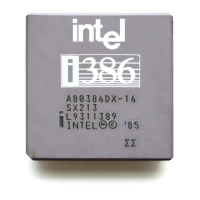Dual-Core Intel® Xeon® Processor 5100 Series Thermal/Mechanical Design Guide 15
Thermal/Mechanical Reference Design
A potential mechanical solution for heavy heatsinks is the direct attachment of the
heatsink to the chassis pan. In this case, the strength of the chassis pan can be utilized
rather than solely relying on the baseboard strength. In addition to the general
guidelines given above, contact with the baseboard surfaces should be minimized
during installation in order to avoid any damage to the baseboard.
The Intel reference design for Dual-Core Intel Xeon Processor 5100 Series is using such
a heatsink attachment scheme. Refer to Section 2.4 for further information regarding
the Intel reference mechanical solution.
2.2 Processor Thermal Parameters and Features
2.2.1 Thermal Control Circuit and TDP
The operating thermal limits of the processor are defined by the Thermal Profile. The
intent of the Thermal Profile specification is to support acoustic noise reduction through
fan speed control and ensure the long-term reliability of the processor. This
specification requires that the temperature at the center of the processor IHS, known
as (T
CASE
) remains within a certain temperature specification. Compliance with the
T
CASE
specification is required to achieve optimal operation and long-term reliability
(See the Intel
®
Xeon
®
Processor Family Thermal Test Vehicle User's Guide for Case
Temperature definition and measurement methods).
To ease the burden on thermal solutions, the Thermal Monitor feature and associated
logic have been integrated into the silicon of the processor. One feature of the Thermal
Monitor is the Thermal Control Circuit (TCC). When active, the TCC lowers the
processor temperature by reducing power consumption. This is accomplished through a
combination of Thermal Monitor and Thermal Monitor 2(TM2).Thermal Monitor
modulates the duty cycle of the internal processor clocks, resulting in a lower effective
frequency, when active, the TCC turns the processor clocks off and then back on with a
predetermined duty cycle. Thermal Monitor 2 adjusts both the processor operating
frequency (via the bus multiplier) and input voltage (via the VID signals). Please refer
to applicable processor Datasheet for further details on TM and TM2.
PROCHOT# is designed to assert at or a few degrees higher than maximum T
CASE
(as
specified by the thermal profile) when dissipating TDP power, and cannot be interpreted
as an indication of processor case temperature. This temperature delta accounts for
processor package, lifetime, and manufacturing variations and attempts to ensure the
Thermal Control Circuit is not activated below maximum T
CASE
when dissipating TDP
power. There is no defined or fixed correlation between the PROCHOT# assertion
temperature and the case temperature. However, with the introduction of the Digital
Thermal Sensor (DTS) on the Dual-Core Intel
®
Xeon
®
Processor 5100 Series, the DTS
reports a relative temperature delta below the PROCHOT# assertion temperature (see
Section 2.2.2 for more details on the Digital Thermal Sensor). Thermal solutions must
be designed to the processor specifications (that is, Thermal Profile) and cannot be
adjusted based on experimental measurements of T
CASE
, PROCHOT#, or Digital
Thermal Sensor on random processor samples.
By taking advantage of the Thermal Monitor features, system designers may reduce
thermal solution cost by designing to the Thermal Design Power (TDP) instead of
maximum power. TDP should be used for processor thermal solution design targets.
TDP is not the maximum power that the processor can dissipate. TDP is based on
measurements of processor power consumption while running various high power
applications. This data set is used to determine those applications that are interesting
from a power perspective. These applications are then evaluated in a controlled
thermal environment to determine their sensitivity to activation of the thermal control

